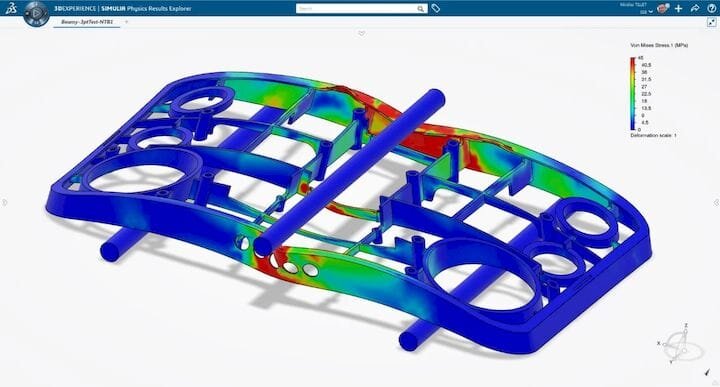 Simulation run on the cloud. (Image courtesy of Dassault Systèmes.)
Simulation run on the cloud. (Image courtesy of Dassault Systèmes.)
The business of product design is changing. With the proliferation of inexpensive laptops, the improvement of mobile hardware and the growing number of digitally native engineers passing from university to the workforce, the engineering ground of old is giving way to a new terrain of app and cloud-based design and simulation workflows.
Today, engineers have access to more tools than ever before, thanks in part to the changing demands of advanced CAD and a shift in the economics of these CAD and CAE platforms.
A World Digitally Reordered
Growing up digitally native was an easy journey for today’s young engineers but hard to match for those with a generation-long stake in the game. To be sure, digital tools have made it easier to navigate the design process; however, the rapidity of technological change over the last 20 years has been staggering, and that has required a shift in mindset.
Just think about it for a second.
Take, for example, storing data on local disks and burning CDs, processes that have been replaced with cloud storage services such as Dropbox since 2008 and Google Drive in 2012. Smartphone users know to have Google automatically store all their photos. Google never seems to tire of offering free cloud solutions, letting users create, save and even collaborate on documents and spreadsheets.
Since then, the acceleration of computation power has continued.
Bulky laptops have given way to sleek computing units and the background of this transformation, steadily gathering an enormous capacity, has been the development of the cloud—an array of ever growing computational resources that can be called upon on demand to store, manage and process data for anyone.
Undoubtedly, the cloud has been the most transformative technology to enter the engineering space in the last 20 years. With its vast and ever-growing power, the cloud has the storage and computational capacity to host any engineering project, no matter how complex. Furthermore, the cloud can also be called upon to process vast amounts of data, making it the perfect conduit for simulation solvers.
And these two realities have allowed both young engineers, and those who make the engineers’ tools, to think about cloud-based design and simulation.
The Advantage of Cloud-Based Design Tools
It wasn’t so long ago that CAD tools followed the tried-and-true pricing-per-seat model. In that paradigm, a company would purchase a separate seat of an engineering package for each engineer on their team and install that software suite on an expensive workstation dedicated to that user. Updates for that package would happen a few times a year, and when the next year rolled around companies would consider buying additional seats according to their needs.
Rinse and repeat.
To complicate matters, this old CAD model often offered packages that were siloed and required additional software purchases if, for example, specialized design or simulation were required to complete a project.
That model didn’t leave much room for flexibility.
Were engineers supposed to be designing all day long? If they weren’t, was the dormant software going to waste? What about down times when the company’s need for design services decreased? What was to be done with surplus licenses?
Fortunately, that old paradigm has changed.
Modern CAD tools are now also being offered on a subscription model that can be toggled on and off as a design company’s needs change. These subscription models don’t require pay-for-play upgrades or updates—they happen automatically, and are built into the monthly subscription fee. Since these systems are run from the cloud, the hardware required for each new user is minimal. What’s more, subscriptions to modern CAD software come in complete bundles where versioning, collaboration, specialized design tools and more are bundled into one unit with a single charge.
The Advantage of Cloud-Based Simulation Tools
Following the example of cloud-based design tools, cloud-based simulation tools have further extended an engineer’s ability to be flexible with their design work. With cloud-based simulation tools, engineers can investigate the validity of their ideas through structural, acoustic, vibration, electromagnetic, fluids and other forms of analysis. Cloud-based simulation also offers the ability to work with new modes of production, such as generative design which creates optimized shapes that can be constructed using additive manufacturing technology.
In the past, these tools were reserved for those who could afford to invest in add-on simulation packages, sometimes even from completely separate simulation software brands. Additionally, simulation software was often designed to be used by experts who was required to build the models and run the solutions.
What sets the cloud-based simulation model apart from its previous incarnation is that the new model removes the need for expensive, dedicated, local computational resources to solve complex problems. With the cloud, a simulation job can be set up on a local laptop, submitted to the cloud, solved remotely and returned to the user rapidly and with no downtime for the local machine. As an added bonus, these new simulation processes are designed to be used by designers themselves, giving immediate access to the designer and easing the burden on engineers with a specific pedigree in simulation mechanics.
Up to now, all we’ve been talking about is the theoretical idea of CAD and CAE in the cloud. What does it actually mean to be an engineer operating in this new paradigm of cloud-based design and simulation?
Read more at ENGINEERING.com

